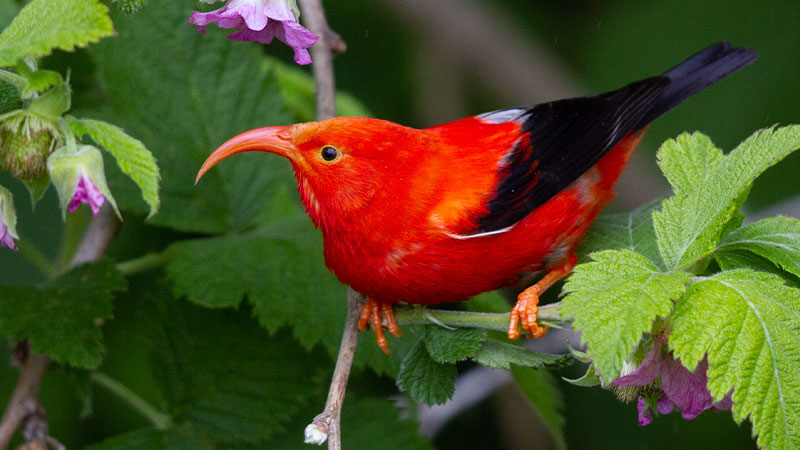Honeycreepers
Hawaiian Honeycreeper (Drepanidinae)
By Dr. Gabrielle Names, UC-Davis – completed PhD working on Amakihi

The Hawaiian Honeycreepers (subfamily Drepanidinae) are a group of over 50 species and subspecies endemic to Hawaii (Atkinson & LaPointe 2009). Situated within the cardueline finch clade, the Hawaiian Honeycreepers are passerine birds that evolved approximately 7.2 million years ago from a single, large, mixed-sex flock of common rosefinches that likely arrived from Asia (Lerner et al. 2011). The group represents one of the most impressive examples of adaptive radiation on earth and boasts striking morphological diversity, from their array of bill forms, some of which have never been documented in other species, as well as their coloration, which include greens, yellows, and reds amid black, gray, and white (Ziegler 2002).
In addition to their biological significance, the Hawaiian Honeycreepers play an important role in the culture of the native Hawaiians. Their feathers, for example, are the defining element of many traditional Hawaiian crafts and garments. Historically, Hawaiian alii (nobility) adorned themselves with intricate feather helmets, crowns, leis, and cloaks and displayed impressive feather standards on special occasions and/or for protection in battle. Additionally, homages to the birds’ songs and vibrant colors are abundant in the traditional Hawaiian stories, chants, and hulas that are performed to this day at Hawaiian celebrations and festivals (Pratt 2009).
Unfortunately, the Hawaiian Honeycreepers are also known worldwide for their high rate of extinction. Of the 50+ original species and subspecies, 17 are extinct and an additional 24 are federally endangered, although a handful of the latter have not been sighted in more than ten years and are likely extinct as well (Pratt 2009). Native Hawaiian bird declines are largely related anthropogenic disturbances (Olson & James 1982). When the Polynesians first began populating the Hawaiian Islands around 800 AD, they brought with them a variety of introduced species, including rats, pigs, and dogs. Predation by these species, along with human hunting and habitat modification, led to the extinction of almost 40 bird species (Pratt 2009).
More recent declines have been linked to habitat loss (largely the result of widespread cultivation of non-native crops, such as sandalwood and sugar cane) and introduced diseases (Pratt 2009). Initial introductions of avian malaria in the early 1900s were followed closely by declines and extinctions of multiple Hawaiian Honeycreepers. Most Hawaiian Honeycreepers are highly susceptible to the disease, with experimental infections establishing mortality rates of some species as high as 90% after a single inoculation (Atkinson et al. 1995, Atkinson & LaPointe 2009). Fortunately, these impacts have largely been limited to birds living in habitats at low elevations because the malaria vector, the Culex mosquito, is cold intolerant, and development of malaria parasites is hampered in cold environments (LaPointe et al. 2010). However, as temperatures increase and weather patterns become more variable with climate change, avian malaria threatens to invade the high elevation refugia (Atkinson & LaPointe 2009).
Remarkably, the Hawaii Amakihi (Hemignathus virens) is the only Honeycreeper that has maintained stable populations at low elevations, where mosquitos carrying avian malaria are prevalent. A recent multi-year survey of these populations on Hawaii Island demonstrated that while almost all lowland (< 900 m) Amakihi were infected with avian malaria, lowland Amakihi mortality due to avian malaria was lower than that of highland (> 900 m) Amakihi (Samuel et al. 2015). Further, in a controlled lab study in which uninfected highland and lowland Amakihi were experimentally infected with avian malaria, all individuals experienced equally high parasite loads following infection but the mortality and weight loss of lowland individuals was significantly lower than that of highland individuals. These findings suggest that lowland Amakihi, which survive inoculation with malarial parasites but remain chronically infected for life, have evolved a form of tolerance to avian malaria (Atkinson et al. 2013). Researchers are currently working to identify the genes and mechanisms that may be responsible for this ability to cope with the disease.
References
Atkinson, C. T., Woods, K. L., Dusek, R. J., Sileo, L. S., & Iko, W. M. (1995). Wildlife disease and conservation in Hawaii: pathogenicity of avian malaria (Plasmodium relictum) in experimentally infected Iiwi (Vestiaria coccinea). Parasitology, 111(S1), S59-S69.
Atkinson, C. T., & LaPointe, D. A. (2009). Introduced avian diseases, climate change, and the future of Hawaiian honeycreepers. Journal of Avian Medicine and Surgery, 23(1), 53-63.
Atkinson, C. T., Saili, K. S., Utzurrum, R. B., & Jarvi, S. I. (2013). Experimental evidence for evolved tolerance to avian malaria in a wild population of low elevation Hawai ‘i ‘Amakihi (Hemignathus virens). EcoHealth, 10(4), 366-375.
LaPointe, D. A., Goff, M. L., & Atkinson, C. T. (2010). Thermal constraints to the sporogonic development and altitudinal distribution of avian malaria Plasmodium relictum in Hawai’i. Journal of Parasitology, 96(2), 318-324.
Lerner, H. R., Meyer, M., James, H. F., Hofreiter, M., & Fleischer, R. C. (2011). Multilocus resolution of phylogeny and timescale in the extant adaptive radiation of Hawaiian honeycreepers. Current Biology, 21(21), 1838-1844.
Olson, S. L., & James, H. F. (1982). Fossil birds from the Hawaiian Islands: evidence for wholesale extinction by man before western contact. Science, 217(4560), 633-635.
Pratt, T. K., Atkinson, C. T., & Banko, P. C. (2009). Conservation biology of Hawaiian forest birds: implications for island avifauna. Yale University Press.
Samuel, M. D., Woodworth, B. L., Atkinson, C. T., Hart, P. J., & LaPointe, D. A. (2015). Avian malaria in Hawaiian forest birds: infection and population impacts across species and elevations. Ecosphere, 6(6), 1-21.
Yorinks, N., & Atkinson, C. T. (2000). Effects of malaria on activity budgets of experimentally infected juvenile Apapane (Himatione sanguinea). The Auk, 117(3), 731-738.
Ziegler, A. C. (2002). Hawaiian natural history, ecology, and evolution. University of Hawaii Press.



